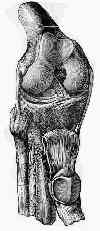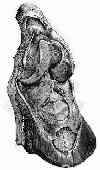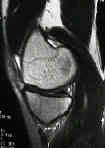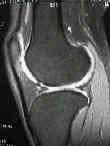 - See: Knee Joint Menu
- See: Knee Joint Menu
- Discussion:
- arthroscopy of the arthritic knee
- Arthroscopy following TKR
- chondral and osteochondral injuries of the knee
- meniscal tears:
- prevalence of wrong pre-operative diagnosis or additional pathology:
- always consider an alternative diagnosis especially in younger patients (in whom bone tumors should be considered);
- " isolated medial meniscal tear"
- actually occurs only 21% of time;
- additional dx in 23%;
- lateral meniscal tear 5% of time (referred pain)
- in 70% of ACL tears, there will be a meniscus tear;
- Portals:
- anteroloateral portal
- superomedial portal
- medial portals 
- superolateral portal:
- useful viewing dynamics of patellofemoral articulation.
- portal located just lateral to the quadriceps tendon about 2.5 cm superior to the superolateral corner of the patella;
- in addition to the skin incision, the knife should nick the deep fascia to facilitate portal insertion;
- reference:
- Posterior portals for arthroscopic surgery of the knee.
- Patellofemoral Joint:
- see: chondromalacia and osteochondral lesions);
- it is important to visualize the entire lateral and medial patellar facets (including the odd facet at the medial aspect of the medial facet);
- normal patellar position in the extended knee is slightly lateral to the lateral femoral condyle, patella moving medially and distally w/ increasing flexion;
- increasing contact occurs between lateral patellar facet & lateral femoral condyle;
- most often patella seats in the center of trochlea at about 45 deg of flexion (and w/ suspected patellar subluxation, it is important to document the amount of knee flexion that elicits patellar contact and full patellar seating);
- any plans for a lateral retinacular release should be delayed until the arthroscopy is completed, since bleeding from this procedure will interfere with visualization;
- Supra-patellar Pouch:
- most often affected by inflammatory arthritis (w/ hypertrophic synovium);
- medial synovial plicae
- reference:
- Arthroscopic examination of the patellofemoral joint using a central, one-portal technique.
 - Medial Compartment:
- Medial Compartment:
- chondral injuries of the knee
- these lesions are identified by flexing the knee to 45 deg;
- visualization of the medial meniscus
- begin by flexing the knee and holding the tibia in external rotation;
- while holding external rotation, apply valgus, and extend the leg to between 10-30 deg;
- note that an ACL deficient will tend to pivot w/ valgus stress, which brings the tibia forward thus imparing visualization of the posterior compartment;
- solution is to firmly hold the tibia in external rotation, which prevents the tibia from subluxing forward;
- gently titrate flexion and extension to give the best visualization of the posterior meniscal horn;
- in difficult cases, an assitant can ballott both the medial and lateral menisci which can facilitate visualization and menisectomy;
- if an assistant is not available a spinal needle can be inserted into the posteror medial aspect of the joint to hold the meniscus in a anterior position;
- references:
- Arthoscopic visual field mapping at the periphery of the medial meniscus: a comparison of different portal approaches.
- Evaluation of arthrography and arthroscopy for lesions of the posteromedial corner of the knee.
- Intercondylar Notch:
- ACL
- PCL
- for optimal assessment of the intercondylar notch, the surgeon should strive for the widest panoramic view that is possible w/ the 30 deg scope directed laterally;
- often the ligamentum mucosum will have to be taken down inorder to improve visualization;
- if the fat pad appear to be in the way, then try a quick "push - pull" with the arthroscope inorder to pull the fat pad backwards;
- if the fat pad continues to obstruct visualization of the notch, it will need to be partially shaved away;
- extend the knee and begin shaving above the intercondylar notch, and then work inferiorly;
- this method allows good visualization as the fat pad is being shaved;
- fat pad syndrome or Hoffa's disease may be diagnosed arthroscopically when there is hypertrophic intercondylar/or infrapatellar synovitis extending to central to the inner rim of the anterior horn of the meniscus;
- references:
- Hoffa's disease: arthroscopic resection of the infrapatellar fat pad.
- Impingement of infrapatellar fat pad (Hoffa's disease): results of high-portal arthroscopic resection.
- posteromedial drive through:
- a required part of any knee arthroscopy is the posteromedial drive thru;
- the scope is slid along the lateral side of the medial femoral condyle (under the PCL) until it reaches the posterior compartment;
- in cases of large posterior horn tears (or displaced bucket handle tears), the torn portion of the meniscus may flip up into the posterior compartment;
- this portion of the meniscus will not been seen from the medial compartment;
- reference:
- Arthroscopic examination of the posteromedial compartment of the knee joint.

- Lateral Compartment:
- visualization of lateral compartment
- lateral meniscus
- popliteus tendon:
- this tendon, arises from distal part of lateral femoral condyle just anterior to origin of the lateral collateral ligament;
- Complications of Arthroscopy:
- infection:
- note that there are several different methods of sterilizing arthroscopic instruments, and that some are better than others;
- references:
- Septic arthritis following arthroscopic meniscus repair: a cluster of three cases.
- Septic arthritis following arthroscopy: Clinical syndromes and analysis of risk factors.
- vascular and nerve injury
- neural disruption / neuropraxia - is usually secondary to prolonged tourniquet times;
- neurologic complications
- references:
- Current Concepts Review. Neurological Complications Due to Arthroscopy.
- Injury to infrapatellar branch of saphenous nerve in arthroscopic knee surgery.
- synovitis
- persistent drainage
- effusions are common
- hemarthrosis
- iatrogenic fracture
- references:
- Supracondylar femoral fracture after anterior cruciate ligament reconstruction with transfemoral fixation.
- Extra articular arthroscopic release in post-traumatic stiff knees: a prospective study of endoscopic quadriceps and patellar release.
- Serious consequences of the wrong diagnosis of meniscal lesion in a case of stress fracture of the distal femur.
- COMPLICATIONS OF KNEE SURGERY
- Complications in Arthroscopic Surgery Performed by Experienced Arthroscopists.
- Supracondylar femoral fracture after arthroscopic reconstruction of the anterior cruciate ligament. A case report.
- Knee surgery: complications, pitfalls, and salvage
- deep venous thrombosis
- in the report by Wirth T, et al., in order to evaluate the risk of VTE in knee arthroscopy patients inorder to determine efficacy and safety of a low-molecular weight heparin (LMWH) (reviparin sodium) in preventing VTE.
- there were 262 patients undergoing elective knee arthroscopy prospectively randomized to receive either no treatment or reviparin once daily subcutaneously for 7 to 10 days.
- 239 patients were evaluable (122 no treatment, 117 receiving LMWH). 6 DVT were detected - 5 in control group (5/117 - 4.1%) and only one in the active treatment group (1/116 - 0.85%).
- 1 patient had a transitory fall in platelet count below 100 giga-particles/L without any clinical symptoms.
- patients undergoing knee arthroscopy have a moderate risk of VTE and effective prophylaxis can be achieved with LMWH (reviparin).
- references:
- Prevention of venous thromboembolism after knee arthroscopy with low-molecular weight heparin (Reviparin). Results of a randomized controlled trial
- Incidence of Symptomatic Venous Thromboembolism After Elective Knee Arthroscopy
Increasing the Osmolarity of Joint Irrigation Solutions May Avoid Injury to Cartilage: A Pilot Study
Alternatives to Total Knee Replacement: Autologous Hamstring Resurfacing Arthroplasty


